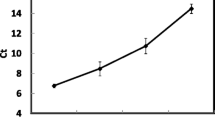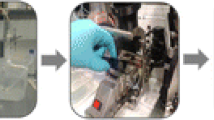Abstract
Legionella pneumophila may cause a fatal pneumonia in humans known as Legionnaires’ disease (LD). The strategies of L. pneumophila to adapt to and resist stressful environmental conditions include the ability to enter into a VBNC (viable but not culturable) state. The detection of L. pneumophila in environmental samples benefits from the use of standardised methods: for detection and enumeration following membrane filtration (AFNOR T90-431, ISO 11731) and detection and quantification by polymerase chain reaction PCR (AFNOR T90-471, ISO 12869). Culture is hampered by its inability to detect VBNC forms and PCR is unable to discriminate between live and dead bacteria. The present immunosensor was obtained by the immobilisation of a monoclonal anti-L. pneumophila antibody (MAb) on an indium-tin oxide (ITO) electrode by the self-assembled monolayers (SAMs) method using an aminosilane. The immunosensor was characterised by wettability (contact angle measurement), atomic force microscopy (AFM), confocal laser scanning microscopy (CLSM), and electrochemical impedance spectroscopy (EIS). A limit of detection of 10 bacteria per mL was observed on artificial samples.
Similar content being viewed by others
References
Ahuja, T., Rajesh Kumar, D., Kumar Tanwar, V., Sharma, V., Singh, N., & Biradar, A. M. (2010). An amperometric uric acid biosensor based on Bis[sulfosuccinimidyl] suberate crosslinker/3-aminopropyltriethoxysilane surface modified ITO glass electrode. Thin Solid Films, 519 1128–1134. DOI: 10.1016/j.tsf.2010.08.056.
Allegra, S., Berger, F., Berthelot, P., Grattard, F., Pozzetto, B., & Riffard, S. (2008). Use of flow cytometry to monitor Legionella viability. Applied and Environmental Microbiology, 74 7813–7816. DOI: 10.1128/aem.01364-08.
Allegra, S., Grattard, F., Girardot, F., Riffard, S., Pozzetto, B., & Berthelot, P. (2011a). Longitudinal evaluation of the efficacy of heat treatment procedures against Legionella spp. in hospital water systems by using a flow cytometric assay. Applied and Environmental Microbiology, 77 1268–1275. DOI: 10.1128/aem.02225-10.
Allegra, S., Girardot, F., Grattard, F., Berthelot, P., Helbig, J. H., Pozzetto, B., & Riffard, S. (2011b). Evaluation of an immunomagnetic separation assay in combination with cultivation to improve Legionella pneumophila serogroup 1 recovery from environmental samples. Journal of Applied Microbiology, 110 952–961. DOI: 10.1111/j.1365-2672.2011.04955.x.
Alleron, L., Khemiri, A., Koubar, M., Lacombe, C., Coquet, L., Cosette, P., Jouenne, T., & Frere, J. (2013). VBNC Legionella pneumophila cells are still able to produce virulence proteins. Water Research, 47 6606–6617. DOI: 10.1016/j.watres.2013.08.032.
Asenath-Smith, E., & Chen, W. (2008). How to prevent the loss of surface functionality derived from aminosilanes. Langmuir, 24 12405–12409. DOI: 10.1021/la802234x.
Braiek, M., Bekir Rokbani, K., Chrouda, A., Mrabet, B., Bakhrouf, A., Maaref, A., & Jaffrezic-Renault, N. (2012). An electrochemical immunosensor for detection of Staphylococcus aureus bacteria based on immobilization of antibodies on self-assembled monolayers-functionalized gold electrode. Biosensors, 2 417–426. DOI: 10.3390/bios2040417.
Benson, R. F., & Fields, B. S. (1998). Classification of the genus Legionella. Seminars in Respiratory Infections, 13 90–9.
Doleans, A., Aurell, H., Reyrolle, M., Lina, G., Freney, J., Vandenesch, F., Etienne, J., & Jarraud, S. (2004). Clinical and environmental distributions of Legionella strains in France are different. Journal of Clinical Microbiology, 42 458–460. DOI: 10.1128/jcm.42.1.458-460.
Epalle, T., Girardot, F., Allegra, S., Maurice-Blanc, C., Garraud, O., & Riffard, S. (2015). Viable but not culturable forms of Legionella pneumophila generated after heat shock treatment are infectious for macrophage-like and alveolar epithelial cells after resuscitation on Acanthamoeba polyphaga. Microbial Ecology, 69 215–224. DOI: 10.1007/s00248-014-0470-x.
Escamilla-Gómez, V., Campuzano, S., Pedrero, M., & Pingarrón, J. M. (2009). Gold screen-printed-based impedimetric immunobiosensors for direct and sensitive Escherichia coli quantisation. Biosensors and Bio electronics, 24 3365–3371. DOI: 10.1016/j.bios.2009.04.047.
Eum, N. S., Yeom, S. H., Kwon, D. H., Kim, H. R., & Kang, S. W. (2010). Enhancement of sensitivity using gold nanorods—Antibody conjugator for detection of E. coli O157:H7. Sensors and Actuators B: Chemical, 143 784–788. DOI: 10.1016/j.snb.2009.09.054.
Fields, B. S., Benson, R. F., & Besser, R. E. (2002). Legionella and Legionnaires’ disease: 25 years of investigation. Clinical Microbiology Reviews, 15 506–526. DOI: 10.1128/cmr.15.3.506-526.2002.
Fraser, D. W., Tsai, T. R., Orenstein, W., Parkin, W. E., Beecham, H. J., Sharrar, R. G., Harris, J., Mallison, G. F., Martin, S. M., McDade, J. E., Shepard, C. C., & Brachman, P. S. (1977). Legionnaires’ disease: Description of an epidemic of pneumonia. The New England Journal of Medicine, 297 1189–1197. DOI: 10.1056/nejm197712012972201.
Fu, L. L., Zhang, K. W., Li, S. Q., Wang, Y. H., Huang, T. S., Zhang, A. X., & Cheng, Z. Y. (2010). In situ real-time detection of E. coli in water using antibody-coated magnetostrictive microcantilever. Sensors and Actuators B: Chemical, 150 220–225. DOI: 10.1016/j.snb.2010.07.011.
Gunda, N. S. K, Singh, M., Norman, L., Kaur, K., & Mitra, S. K. (2014). Optimization and characterization of biomolecule immobilization on silicon substrates using (3-aminopropyl)triethoxysilane (APTES) and glutaraldehyde linker. Applied Surface Science, 305 522–530. DOI: 10.1016/j.apsusc.2014.03.130.
Henke, L., & Krull, U. J. (1999). Immobilization technologies used for nucleic acid biosensors. Canadian Journal of Analytical Sciences and Spectroscopy, 44 61–70.
Kim, B. R., Anderson, J. E., Mueller, S. A., Gaines, W. A., & Kendall, A. M. (2002). Literature review — efficacy of various disinfectants against Legionella in water systems. Water Research, 36 4433–4444. DOI: 10.1016/s0043-1354(02)00188-4.
Lei, K. F., & Leung, P. H. M. (2012). Microelectrode array biosensor for the detection of Legionella pneumophila. Microelectronic Engineering, 91 174–177. DOI: 10.1016/j.mee.2011.10.002.
Li, N., Brahemendra, A., Veloso, A. J., Prashar, A., Cheng, X. R., Hung, V. W. S., Guyard, C., Terebiznik, M., & Kerman, K. (2012). Disposable immunochips for the detection of Legionella pneumophila using electrochemical impedance spectroscopy. Analytical Chemistry, 84 3485–3488. DOI: 10.1021/ac3003227.
Mishra, S. K., Kumar, D., Biradar, A. M., & Rajesh (2012). Electrochemical impedance spectroscopy characterization of mercaptopropionic acid capped ZnS nanocrystal based bioelectrode for the detection of the cardiac biomarker—myoglobin. Bio electro chemistry, 88 118–126. DOI: 10.1016/j.bioelechem.2012.07.006.
Nagare, G. D., & Mukherji, S. (2009). Characterization of silanization and antibody immobilization on spin-on glass (SOG) surface. Applied Surface Science, 255 3696–3700. DOI: 10.1016/j.apsusc.2008.10.033.
Oliver, J. D. (2000). The viable but nonculturable state and cellular resuscitation. In C. R. Bell, M. Brylinsky, & P. C. Johnson-Green (Eds.), Microbial biosystems: New frontiers, Proceedings of the 8th International Symposium on Microbial Ecology, August 9–14, 1998, Halifax, Canada, (pp. 723–730). Halifax, Canada: Atlantic Canada Society for Microbial Ecology.
Oliver, J. D. (2005). The viable but nonculturable state in bacteria. Journal of Microbiology, 43 93–100.
Puertas, S., de Gracia Villa, M., Mendoza, E., Jiménez-Jorquera, C., de la Fuente. J. M., Fernández-Sánchez, C., & Grazú, V. (2013). Improving immunosensor performance through oriented immobilization of antibodies on carbon nanotube composite surfaces. Biosensors and Bioelectronics, 43 274–280. DOI: 10.1016/j.bios.2012.12.010.
Qin, M., Hou, S., Wang, L. K., Feng, X. Z., Wang, R., Yang, Y. L., Wang, C., Yu, L., Shao, B., & Qiao, M. Q. (2007). Two methods for glass surface modification and their application in protein immobilization. Colloids and Surfaces B: Biointerfaces, 60 243–249. DOI: 10.1016/j.colsurfb.2007.06.018.
Souiri, M., Blel, N., Sboui, D., Mhamdi, L., Epalle, T., Mzoughi, R., Riffard, S., & Othmane A (2014). AFM, CLSM and EIS characterization of the immobilization of antibodies on indium-tin oxide electrode and their capture of Legionella pneumophila. Talanta, 118 224–230. DOI: 10.1016/j.talanta.2013.09.049.
Vashist, S. K., Dixit, C. K., MacCraith, B. D., & O’Kennedy, R. (2011). Effect of antibody immobilization strategies on the analytical performance of a surface plasmon resonance-based immunoassay. Analyst, 136 4431–4436. DOI: 10.1039/c1an15325k.
Vashist, S. K. (2012). Comparison of 1-ethyl-3-(3-dimethyl-aminopropyl)carbodiimide based strategies to cosslink antibodies on amine-functionalized platforms for immunodiagnostic applications. Diagnostics, 2 23–33. DOI: 10.3390/diagnostics2030023.
WHO (2006). Gaining health: The European strategy for prevention and control of non-communicable diseases. Copenhagen, Denmark: WHO Regional Office for Europe.
Zor, E., Patir, I. H., Bingol, H., & Ersoz, M. (2013). An electrochemical biosensor based on human serum albumin/graphene oxide/3-aminopropyltriethoxysilane modified ITO electrode for the enantioselective discrimination of d-and l-tryptophan. Biosensors and Bioelectronics, 42 321–325. DOI: 10.1016/j.bios.2012.10.068.
Author information
Authors and Affiliations
Corresponding author
Additional information
S. Riffard and A. Othmane contributed equally to the work
Rights and permissions
About this article
Cite this article
Sboui, D., Souiri, M., Reynaud, S. et al. Characterisation of electrochemical immunosensor for detection of viable not-culturable forms of Legionella pneumophila in water samples. Chem. Pap. 69, 1402–1410 (2015). https://doi.org/10.1515/chempap-2015-0170
Received:
Revised:
Accepted:
Published:
Issue Date:
DOI: https://doi.org/10.1515/chempap-2015-0170




